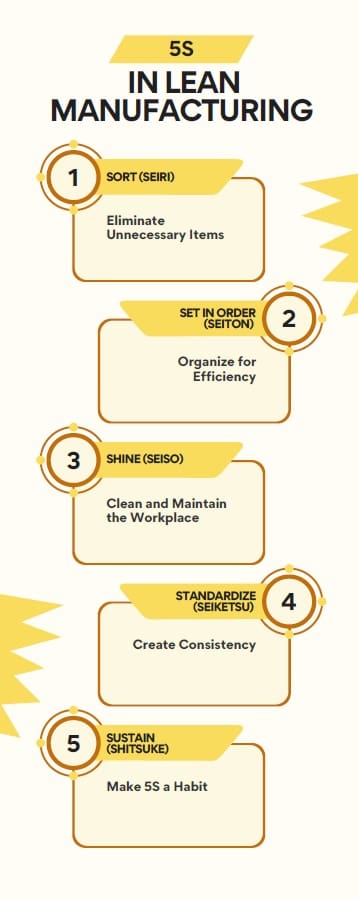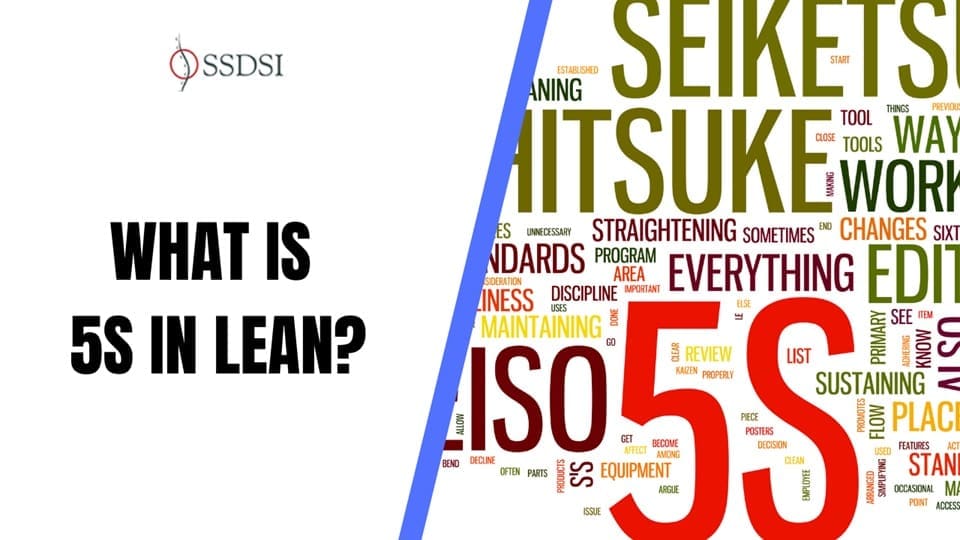The 5S methodology is a powerful tool in Lean management. It helps optimize workplace efficiency and productivity. The system focuses on maintaining an organized, clean, and safe work environment. This helps eliminate waste, streamline processes, and improve employee morale. Hiroyuki Hirano initially developed it in post-war Japan.
Toyota famously implemented the 5S system, and it has since been adopted by businesses worldwide to boost operational efficiency.
The term “5S” refers to five Japanese words that form the foundation of this system. These five principles—Seiri, Seiton, Seiso, Seiketsu, and Shitsuke—translate to Sort, Set in Order, Shine, Standardize, and Sustain, respectively. Each of these principles contributes to creating a work environment that promotes the efficient use of resources, reduces waste, and enhances productivity.
Table of contents
What is 5S in Lean Manufacturing?
5S originated in Japan as part of the Toyota Production System and is now a key component of lean manufacturing. The philosophy behind 5S is that by creating a clean, organized, and well-structured workspace, employees can perform their tasks more effectively with reduced risk and less downtime. When implemented correctly, 5S helps businesses achieve better results by improving workflow, reducing waste, enhancing safety, and increasing overall efficiency.
Lean manufacturing, which includes practices such as Kaizen (continuous improvement), Kanban (visual management), and Jidoka (automation with a human touch), seeks to eliminate non-value-adding activities and create a smooth, efficient production process. The 5S method is a crucial part of this approach, as it provides the framework for maintaining an organized and safe workspace.

1. Sort (Seiri) – Eliminate Unnecessary Items
The first step in the 5S methodology is Sort (Seiri). It involves identifying and eliminating unnecessary items in the workplace. This means separating essential tools, materials, and equipment from those that are not needed. Remove items that are not frequently used or no longer serve a useful purpose from the work area. The goal of this step is to declutter the workspace, making it easier to focus on tasks that add value.
A common technique used in this step is “red-tagging.” In this process, items that are not needed are tagged. These items are then moved to a central location for review. Unnecessary items can be disposed of, recycled, or reassigned. By sorting the workspace, businesses create more room, enhance workflow, and prevent the accumulation of waste.
2. Set in Order (Seiton) – Organize for Efficiency
Once you remove the unnecessary items, the next step is Set in Order (Seiton). This principle emphasizes organizing the remaining items to support smooth operations. Arrange tools, materials, and equipment in a way that makes them easy to access and use. A well-organized workspace reduces the time spent searching for tools or materials and minimizes errors.
The effective organization includes labelling storage locations, colour coding items, and creating designated spaces for different tasks or processes. For example, store tools in labelled cabinets and organize materials on shelves in a logical sequence that matches the flow of production. By setting items in order, workers can easily locate what they need, which increases efficiency and reduces wasted time.
3. Shine (Seiso) – Clean and Maintain the Workplace
The third principle, Shine (Seiso), focuses on cleanliness and maintenance. A clean workplace promotes a healthier and safer environment. It also helps identify potential problems before they become significant issues. For example, cleaning machines and equipment can reveal leaks, misalignments, or signs of wear. If ignored, these issues could lead to equipment failure.
Establish daily cleaning routines as part of this step to keep the workspace tidy and functional. Shine goes beyond cleaning; it also involves inspecting equipment. Ensure everything is in good working order and address any maintenance issues promptly. This step is vital for sustaining the improvements made in the previous steps.
4. Standardize (Seiketsu) – Create Consistency
The fourth principle, Standardize (Seiketsu), aims to create uniformity in the workplace. It standardizes the processes and practices used to maintain the improvements achieved in the previous steps. Once the workspace is sorted, organized, and cleaned, the next step is to establish standardized practices. These practices help sustain the changes over time.
Standardization involves creating procedures and checklists for tasks like sorting, organizing, and cleaning. It also includes setting up regular maintenance schedules and assigning responsibilities to employees. By standardizing these processes, businesses can ensure that the improvements made are consistently maintained. Visual cues, such as signs, labels, and colour codes, are often used. These cues help reinforce the standards and make them easy to follow.
5. Sustain (Shitsuke) – Make 5S a Habit
The final principle, Sustain (Shitsuke), is about maintaining the discipline to keep the workplace organized and efficient over the long term. This step focuses on creating a culture where 5S principles are not just followed temporarily. They must become ingrained in the daily routines of employees.
Sustainability requires ongoing commitment from both employees and management. It is often the most challenging aspect of the 5S methodology. This is because it requires a shift in mindset and behaviour. To ensure that the 5S system is sustained, companies can use tools such as performance reviews, regular audits, and employee training. Positive reinforcement and incentives are also essential. They help motivate employees to consistently adhere to the 5S principles.
Role of Safety in 5S
While the traditional 5S method does not explicitly include safety, many organizations add a sixth S: Safety. Safety is an essential part of any workplace organization. 5S can be a powerful tool for promoting a safe environment. By ensuring that tools and equipment are organized and maintained properly, the risk of accidents and injuries is significantly reduced.
In addition to cleanliness and order, safety measures may involve marking hazardous areas, labelling chemicals, and ensuring ergonomic workstations to prevent injuries. A well-organized, clean workspace contributes to fewer safety hazards. Employees can easily identify and address potential risks. Safety should be integrated into the 5S methodology. This ensures that all workers understand the importance of maintaining a safe environment as part of their daily tasks.
Also See: Lean Six Sigma Certification Programs, Plano, Texas
Why 5S is Essential for Lean Manufacturing?

At its core, 5S is about eliminating waste and improving efficiency. The concept of waste is central to lean manufacturing, and 5S plays a significant role in addressing several types of waste:
- Waste of Motion: By organizing tools and materials efficiently, workers spend less time searching for what they need, reducing unnecessary movements.
- Waste of Waiting: A clean and organized workspace reduces downtime caused by searching for items, waiting for equipment, or dealing with unaddressed issues.
- Waste of Overproduction: Properly organized workspaces ensure that materials are readily available in the right quantity, avoiding overproduction or underproduction.
- Waste of Defects: A clean and well-maintained workspace allows workers to focus on quality, reducing the risk of mistakes or defects.
Benefits of Implementing 5S

The implementation of the 5S system can lead to significant improvements in various areas of a business, including:
Increased Efficiency: By organizing tools, materials, and equipment, employees can find what they need more quickly, reducing downtime and wasted time searching for items. A clean and well-organized workspace also allows for smoother workflows, further increasing efficiency.
Cost Reduction: The 5S method helps eliminate waste in various forms, including excess inventory, wasted time, and unnecessary movement. By streamlining operations, organizations can reduce costs and improve profitability. For example, by eliminating clutter and unnecessary tools, companies can reduce the need for large storage spaces or maintenance costs for unused equipment.
Improved Quality: Standardizing processes and ensuring cleanliness can significantly improve the quality of products and services. With standardized workflows, employees are more likely to follow best practices, leading to fewer errors and defects. Regular cleaning also helps prevent contamination or other issues that could impact product quality.
Enhanced Safety: A clean and organized workspace is inherently safer. By removing hazards, such as cluttered walkways or improperly stored equipment, the risk of accidents and injuries is reduced. In industries such as manufacturing, safety is paramount, and 5S helps create a safer environment for employees.
Employee Engagement: The 5S methodology encourages employee involvement and ownership. When employees are actively engaged in organizing and maintaining their workspaces, they are more likely to feel invested in the company’s success. This sense of ownership can lead to higher job satisfaction, motivation, and overall morale.
Customer Satisfaction: A well-organized, clean, and efficient workplace is often reflected in the products and services that a company provides. By improving quality and reducing lead times, organizations can better meet customer expectations, which can lead to higher customer satisfaction and loyalty.
Real-World Example of 5S Implementation
An example of how 5S principles can be applied is the case of Kaiser Permanente Colorado’s Medicaid Enrollment Project Team. The team used the 5S methodology to improve their enrollment template and process. Here’s how they implemented each of the 5S pillars:
- Sort: The team identified and removed unnecessary fields from the enrollment template.
- Set in Order: They organized the remaining fields in a logical order based on stakeholder input.
- Shine: A Microsoft Access database was created to prevent duplicate entries, effectively “shining” the process by eliminating errors.
- Standardize: They protected the spreadsheet and made it a standardized template for future use.
- Sustain: The team established a self-sustaining system using Microsoft Access and Excel templates to maintain consistency in the process.
This case demonstrates how the 5S methodology can improve physical workplaces. It can also enhance administrative and data management processes.
Challenges and Considerations
While 5S can provide numerous benefits, there are also challenges to implementing this system. One potential issue is resistance to change. This is especially common in organizations where employees are accustomed to older methods. To overcome this, it is essential to have strong leadership and clear communication about the benefits of 5S.
Another challenge is ensuring that 5S principles are consistently followed. Without a system of checks and balances, there is a risk that employees may revert to old habits or become complacent. To prevent this, businesses should regularly review their 5S processes and encourage continuous improvement.
Additionally, while 5S can lead to a reduction in waste and improved efficiency, it is important to consider the environmental impact of implementing the system. For example, cleaning and painting equipment may require the use of chemicals, which could lead to increased waste or emissions if not handled properly.
Final Words
The 5S methodology is an essential tool for any organization looking to improve its efficiency, reduce waste, and create a more productive and safe work environment. By following the five principles—Sort, Set in Order, Shine, Standardize, and Sustain—companies can create a culture of continuous improvement that benefits both employees and customers.
Although the implementation of 5S can be challenging, the long-term rewards in terms of productivity, cost savings, and employee satisfaction make it a valuable investment for any business.
As a foundational element of Lean management, 5S sets the stage for further improvements and lean practices, ultimately helping organizations achieve their operational goals.

About Six Sigma Development Solutions, Inc.
Six Sigma Development Solutions, Inc. offers onsite, public, and virtual Lean Six Sigma certification training. We are an Accredited Training Organization by the IASSC (International Association of Six Sigma Certification). We offer Lean Six Sigma Green Belt, Black Belt, and Yellow Belt, as well as LEAN certifications.
Book a Call and Let us know how we can help meet your training needs.



















